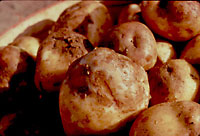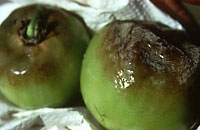Protocol: RG57 genomic DNA fingerprinting
Hybridization with Renaissance non-radioactive kit
These instructions are basically identical to those which come with the kit (sold by NEN life science products catalog # NEL603)
- Production of a fluorescein-labeled probe.
- Thaw all labeling components except for the Klenow Fragment, and place on ice. Keep the Klenow at -20° C until just before use.
- Briefly microfuge all kit components
- Place 250 ng RG57 template DNA in a clean screw cap microfuge tube and dilute with water to a final volume of 19 ul. Put the tube in a 95-100° C heat block for 3-5 min, then quickly place the tube on ice for 5 min.
- Add the following to the microfuge tube containing 19 ul denatured DNA:
| Random primers and reaction buffer mix | 5 ul |
| Fluorescein nucleotide mix | 5 ul |
| Klenow fragment | 1 ul |
| Total volume 30 ul |
- Microfuge the reaction tube briefly and incubate for 1 hour at 37° C. For greater probe synthesis, incubate the reaction overnight at room temperature.
- Terminate the reaction by adding 5 ul 0.1M EDT
- Purification of fluorescein-labeled probes.
- For each probe, use 1 Bio-Rad micro bio-spin column.
- Shake the column several times to resuspend the gel and to remove bubbles.
- Snap off the tip and place the column in a 2.0 ml microfuge tube. Remove the cap from the column. Let the column drip for about 2 min. and discard the drained buffer.
- Centrifuge for 1.5 min at 7,000 in the small microfuge. Discard the drained buffer.
- Add 50 ul TE buffer to your labeled RG57 probe (from step I). Pipette entire sample (85 ul) into the column. Centrifuge for 1.0 min at 7,000 in the small microfuge.
- Add 100 ul TE buffer to the column, and microfuge for 1 min.
- The probe is now finished and can be used immediately or stored at -20° C for 1 year.
- DNA hybridization
Day 1
- Incubate salmon sperm DNA (10 mg/ml) in a 95° C heat block for 5 min. Place immediately on ice for 5 min..
- Wet the membrane containing the denatured target (digested P. infestans) DNA in 2X SSC.
- Insert membrane into a hybridization tube and add prehybridization buffer containing 50 ug/ml salmon sperm DNA. Use 0.1 ml buffer /cm2 of membrane. Our membrane is generally 300 cm2 so we use 30 ml prehybridization buffer and 150 ul salmon sperm DNA (10 mg/ml).
- Incubate at 65° C in a hybridization oven for at least 1 hour.
- Combine the probe (from step II) with 200 ul hybridization buffer and 75 ul salmon sperm DNA. Heat at 95° C for 5 min and immediately place on ice for 5 min.
- Add the denatured probe mix (from step 5) to 15 ml of hybridization buffer which has been warmed to 65° C.
- Empty the prehybridization buffer from the tube (this can be dumped down the drain), and add the hybridization buffer containing the probe and salmon sperm DNA (from step 6).
- Hybridize overnight in the oven at 65° C.
Day 2
- Pour hybridization solution into a tube or bottle and place at -20° C. This solution can be used for a future hybridization.
- Add 100 ml 2.0X SSC, 1.0% SDS to the tube and wash the membrane for 15 min at 65° C. Dump wash solution down the drain.
- Add 100 ml 0.2X SSC, 0.1% SDS to the tube and wash for 15 min at 65° C. Dump wash solution down the drain.
- Carefully remove membrane from tube and place in a clean plastic dish.
IV. Detection
- All of the following steps are done at room temperature.
- Add 300 ml detection buffer 1 to the membrane in a plastic dish and vigorously agitate the membrane for 5 min. We use a shaking platform.
- Place the membrane in 30 ml detection buffer 2 for 1 hour with gentle agitation.
- Add 30 ul antifluorescein-ap conjugate to 30 ml buffer 2, and place the membrane into this antibody conjugate solution. Incubate for 1 hour with gentle agitation.
- Vigorously wash the membrane 4 X 5 min in detection buffer 1.
- Vigorously wash the membrane 2 X 5 min in detection buffer 3.
- Transfer the membrane from the final antibody conjugate wash solution to a clean container. MAKE SURE THE MEMBRANE IS DNA SIDE UP.
- Completely cover the membrane with CDP-Star. We use about 3 ml (0.01ml/cm2 of membrane).
- Incubate the substrate on the membrane for 5 min.
- Gently remove excess solution with blotting paper.
- Wrap the damp membrane with saran wrap.
- Place the prepared membrane, DNA SIDE UP, in a film cassette and place reflection autoradiography film over the membrane.
- Expose the film for 5 minutes, then develop.
Solutions for non-radioactive detection
0.1 M EDTA pH 8.0
Add 3.68 g of disodium EDTA to 80ml of dH2O. Stir vigorously on a magnetic stirrer. Adjust the pH to 8.0 with NaOH. Bring to a final volume of 100 ml with dH2O. Pass through a 0.22 uM filter.
20X SSC
Dissolve 175.4 g of NaCl and 88.2 g of sodium citrate in 800 ml of dH2O. Adjust the volume to 1 liter with H2O. Pass through a 0.22 uM filter.
DNA prehybridization and hybridization solution
2 X SSC
0.5% (w/v) blocking reagent
5% (w/v) dextran sulphate
0.1% (w/v) SDS
To make 100 ml:
Add 10 ml of 20 X SSC and 0.5 g blocking reagent to 50 ml of distilled H2O. Before adding the dextran sulphate, heat gradually up to 60° C with continuous stirring to dissolve the blocking reagent. Slowly (over 2-3 min) add 5 g dextran sulphate and stir until dissolved. Add 0.5 ml of a 20% solution of SDS. Bring to a final volume of 100 ml with dH2O. Store at -20° C when not in use.
Salmon sperm DNA
100 mg Salmon sperm DNA
10 ml H2O
Stir for 1-2 hours until the DNA is dissolved
To sheer the DNA autoclave for 10 minutes. Store in aliquots at -20 C.
Hybridization wash 1
2 X SSC, 1.0% SDS
100 ml of 20 X SSC
10 g of SDS
Add water to a total volume of 1 liter
Hybridization wash 2
0.2 X SSC, 0.1% SDS
10 ml of 20 X SSC
1 g of SDS
Add water to a total volume of 1 liter
Detection buffer 1
0.1M Tris, pH 7.5
0.15M NaCl
To make 1.0 Liter:
Combine 12.2 g Tris and 9.0 g NaCl in 500 ml dH2O. Adjust pH to 7.5 with HCl while stirring. Bring to a final volume of 1.0 liter with dH2O. Pass through a 0.22 uM filter. Store at room temperature.
Detection buffer 2
0.1M Tris, pH 7.5
0.15M NaCl
0.5% (w/v) blocking reagent
To make 100 ml:
Comebine 0.5 g of blocking powder with 100 ml detection buffer 1. Heat gradually up to 60° C with continuous stirring to dissolve the blocking reagent. Store at -20° C when not in use.
Detection buffer 3
0.1M Tris, pH9.5
0.2M NaCl
To make 100 ml:
Combine 1.21 g of Tris and 0.59 g of NaCl with 75 ml of dH2O. Adjust pH to 9.5 with HCl. Bring to a final volume of 100 ml with dH2O. Pass through a 0.22 uM filter. Store at room temp.


